Page 74 of 473

73 Safety and Security
Occupant safety
Infant and child restraint systems
Only use a BabySmart
TM compatible child
restraint for the front passenger seat in
this vehicle.
We recommend all infants and children be
properly restrained at all times while the
vehicle is in motion.
All lap-shoulder belts except the driver’s
seat belt have special seat belt retractors
for secure fastening of child restraints.
To fasten a child restraint, follow child
restraint instructions for mounting. Then
pull the shoulder belt out completely and
let it retract. During seat belt retraction,
a ratcheting sound can be heard to indi-
cate that the special seat belt retractor is
activated. The belt is now locked. Push
down on child restraint to take up any
slack.To deactivate, release seat belt buckle and
let seat belt retract completely. The seat
belt can again be used in the usual
manner.
If children open a door, they could
�injure other persons
�get out of the car and injure themselves
or be injured by following traffic
Do not carry heavy or hard objects in the
passenger or cargo compartment unless
they are firmly secured in place. For more in-
formation, see “Loading” (
�page 248) and
“Useful features” (
�page 256).
Unsecured or improperly positioned cargo
increases a child’s risk of injury in the event
of
�strong braking maneuvers
�sudden changes of direction
�an accident
Warning!G
Never release the seat belt buckle while the
vehicle is in motion, since the special seat
belt retractor will be deactivated.
i
For information on child seats with an-
chor fittings for tether anchorages, see
“Installation of infant and child re-
straint systems” (
�page 77).
For information on child seat anchors -
LATCH-type (
�page 79).
Page 78 of 473
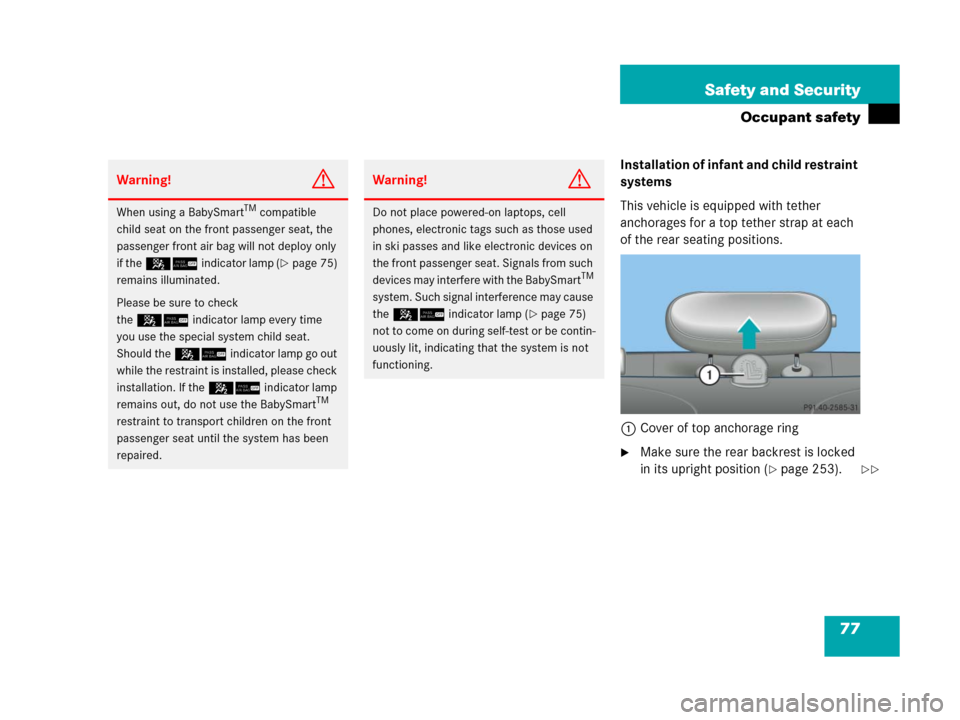
77 Safety and Security
Occupant safety
Installation of infant and child restraint
systems
This vehicle is equipped with tether
anchorages for a top tether strap at each
of the rear seating positions.
1Cover of top anchorage ring
�Make sure the rear backrest is locked
in its upright position (
�page 253).
Warning!G
When using a BabySmartTM compatible
child seat on the front passenger seat, the
passenger front air bag will not deploy only
if the56indicator lamp (
�page 75)
remains illuminated.
Please be sure to check
the56indicator lamp every time
you use the special system child seat.
Should the56indicator lamp go out
while the restraint is installed, please check
installation. If the56indicator lamp
remains out, do not use the BabySmart
TM
restraint to transport children on the front
passenger seat until the system has been
repaired.
Warning!G
Do not place powered-on laptops, cell
phones, electronic tags such as those used
in ski passes and like electronic devices on
the front passenger seat. Signals from such
devices may interfere with the BabySmart
TM
system. Such signal interference may cause
the56indicator lamp (
�page 75)
not to come on during self-test or be contin-
uously lit, indicating that the system is not
functioning.
��
Page 79 of 473
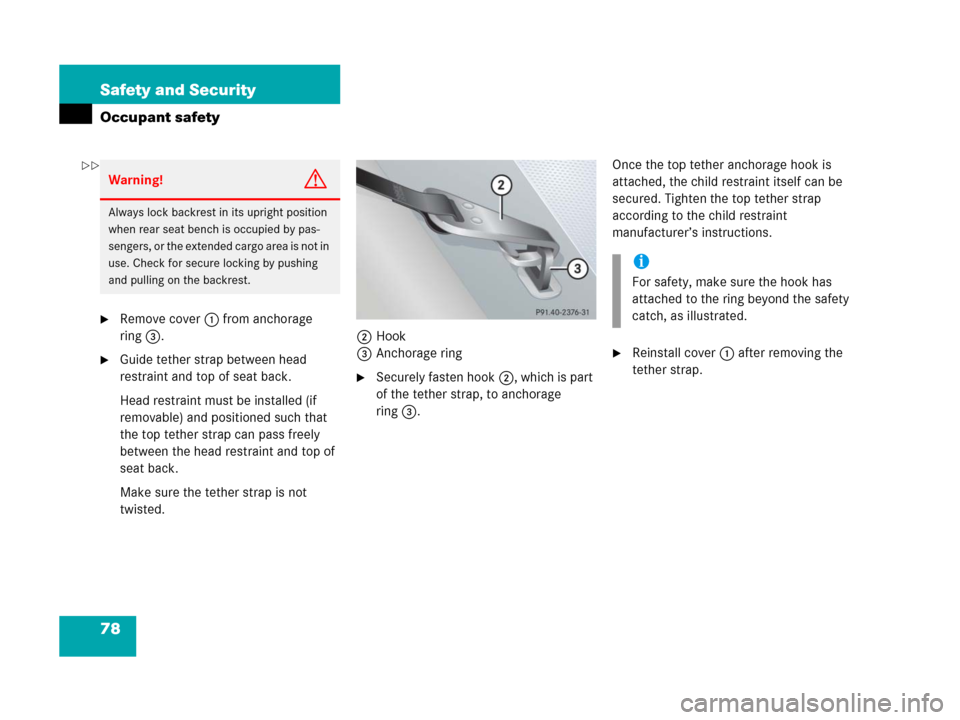
78 Safety and Security
Occupant safety
�Remove cover1 from anchorage
ring3.
�Guide tether strap between head
restraint and top of seat back.
Head restraint must be installed (if
removable) and positioned such that
the top tether strap can pass freely
between the head restraint and top of
seat back.
Make sure the tether strap is not
twisted.2Hook
3Anchorage ring
�Securely fasten hook2, which is part
of the tether strap, to anchorage
ring3.Once the top tether anchorage hook is
attached, the child restraint itself can be
secured. Tighten the top tether strap
according to the child restraint
manufacturer’s instructions.
�Reinstall cover1 after removing the
tether strap.
Warning!G
Always lock backrest in its upright position
when rear seat bench is occupied by pas-
sengers, or the extended cargo area is not in
use. Check for secure locking by pushing
and pulling on the backrest.
i
For safety, make sure the hook has
attached to the ring beyond the safety
catch, as illustrated.
��
Page 81 of 473
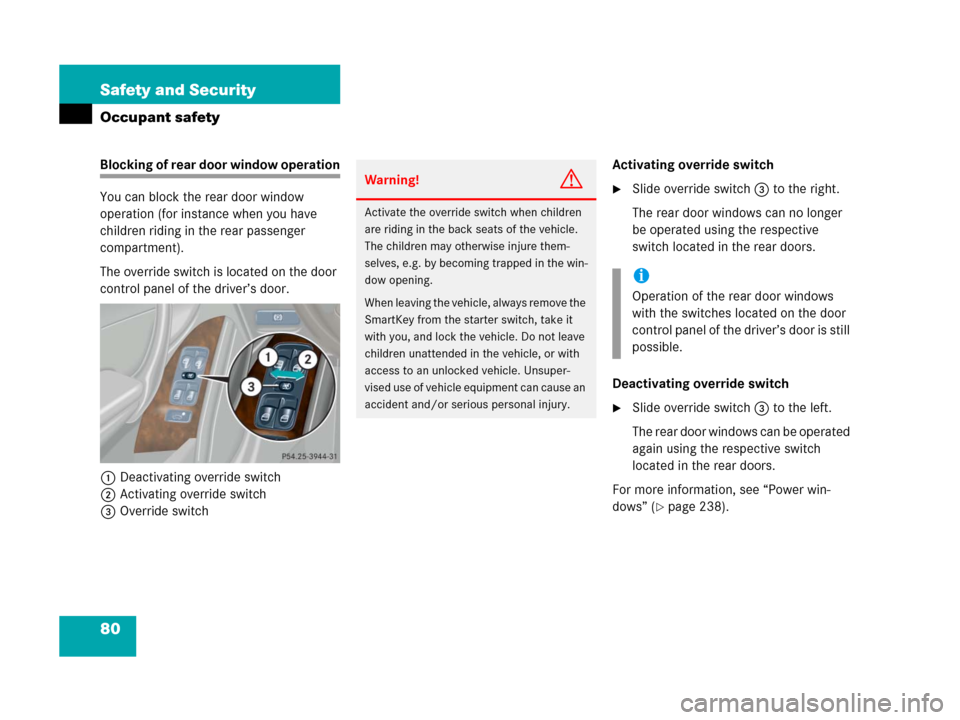
80 Safety and Security
Occupant safety
Blocking of rear door window operation
You can block the rear door window
operation (for instance when you have
children riding in the rear passenger
compartment).
The override switch is located on the door
control panel of the driver’s door.
1Deactivating override switch
2Activating override switch
3Override switchActivating override switch
�Slide override switch3 to the right.
The rear door windows can no longer
be operated using the respective
switch located in the rear doors.
Deactivating override switch
�Slide override switch3 to the left.
The rear door windows can be operated
again using the respective switch
located in the rear doors.
For more information, see “Power win-
dows” (
�page 238).
Warning!G
Activate the override switch when children
are riding in the back seats of the vehicle.
The children may otherwise injure them-
selves, e.g. by becoming trapped in the win-
dow opening.
When leaving the vehicle, always remove the
SmartKey from the starter switch, take it
with you, and lock the vehicle. Do not leave
children unattended in the vehicle, or with
access to an unlocked vehicle. Unsuper-
vised use of vehicle equipment can cause an
accident and/or serious personal injury.
i
Operation of the rear door windows
with the switches located on the door
control panel of the driver’s door is still
possible.
Page 96 of 473
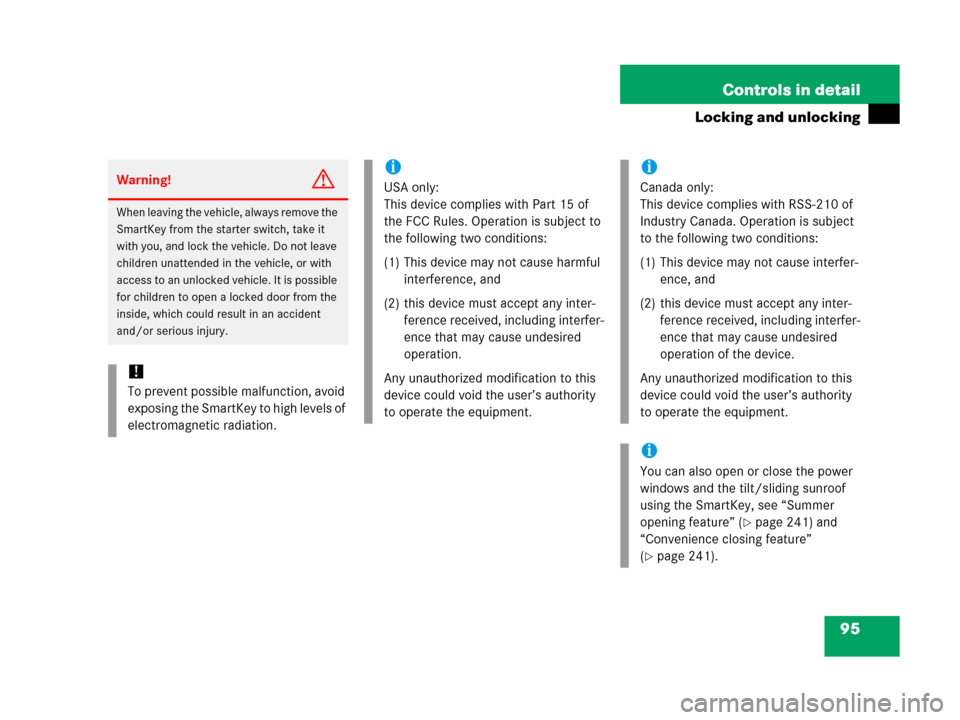
95 Controls in detail
Locking and unlocking
Warning!G
When leaving the vehicle, always remove the
SmartKey from the starter switch, take it
with you, and lock the vehicle. Do not leave
children unattended in the vehicle, or with
access to an unlocked vehicle. It is possible
for children to open a locked door from the
inside, which could result in an accident
and/or serious injury.
!
To prevent possible malfunction, avoid
exposing the SmartKey to high levels of
electromagnetic radiation.
i
USA only:
This device complies with Part 15 of
the FCC Rules. Operation is subject to
the following two conditions:
(1) This device may not cause harmful
interference, and
(2) this device must accept any inter-
ference received, including interfer-
ence that may cause undesired
operation.
Any unauthorized modification to this
device could void the user’s authority
to operate the equipment.
i
Canada only:
This device complies with RSS-210 of
Industry Canada. Operation is subject
to the following two conditions:
(1) This device may not cause interfer-
ence, and
(2) this device must accept any inter-
ference received, including interfer-
ence that may cause undesired
operation of the device.
Any unauthorized modification to this
device could void the user’s authority
to operate the equipment.
i
You can also open or close the power
windows and the tilt/sliding sunroof
using the SmartKey, see “Summer
opening feature” (
�page 241) and
“Convenience closing feature”
(
�page 241).
Page 102 of 473
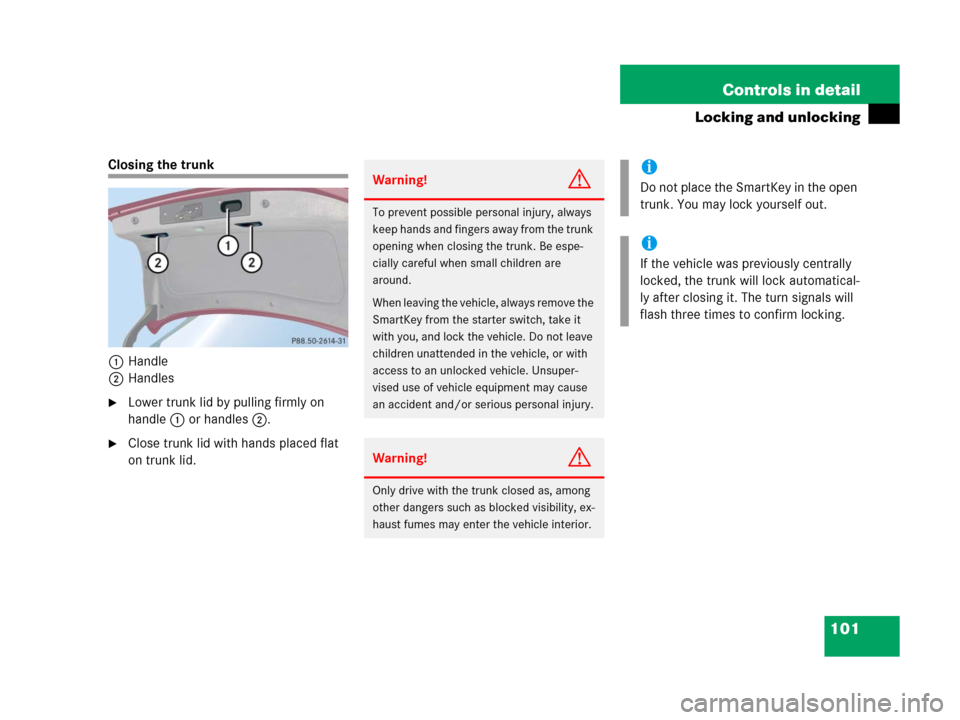
101 Controls in detail
Locking and unlocking
Closing the trunk
1Handle
2Handles
�Lower trunk lid by pulling firmly on
handle1 or handles2.
�Close trunk lid with hands placed flat
on trunk lid.
Warning!G
To prevent possible personal injury, always
keep hands and fingers away from the trunk
opening when closing the trunk. Be espe-
cially careful when small children are
around.
When leaving the vehicle, always remove the
SmartKey from the starter switch, take it
with you, and lock the vehicle. Do not leave
children unattended in the vehicle, or with
access to an unlocked vehicle. Unsuper-
vised use of vehicle equipment may cause
an accident and/or serious personal injury.
Warning!G
Only drive with the trunk closed as, among
other dangers such as blocked visibility, ex-
haust fumes may enter the vehicle interior.
i
Do not place the SmartKey in the open
trunk. You may lock yourself out.
i
If the vehicle was previously centrally
locked, the trunk will lock automatical-
ly after closing it. The turn signals will
flash three times to confirm locking.
Page 105 of 473

104 Controls in detail
Locking and unlocking
Locking and unlocking from the inside
You can lock or unlock the doors and the
trunk from inside using the central locking
or unlocking switch. This can be useful, for
example, if you want to lock the vehicle
before starting to drive.
You cannot lock or unlock the fuel filler flap
with the central locking or unlocking
switch.The switches are located in the center
console.
1Central locking switch
2Central unlocking switch
Warning!G
When leaving the vehicle, always remove the
SmartKey from the starter switch, take it
with you, and lock the vehicle. Do not leave
children unattended in the vehicle, or with
access to an unlocked vehicle. Unsuper-
vised use of vehicle equipment may cause
an accident and/or serious personal injury.
i
You can open a locked door from the
inside. Open door only when conditions
are safe to do so.
If the vehicle was previously centrally
locked using the SmartKey, it will not
unlock using the central unlocking
switch2.
If the vehicle was previously locked
with the central locking switch1
�while in the selective remote con-
trol mode, only the door opened
from the inside is unlocked.
�while in the global remote control
mode, the complete vehicle is
unlocked when a door is opened
from the inside.
Page 149 of 473
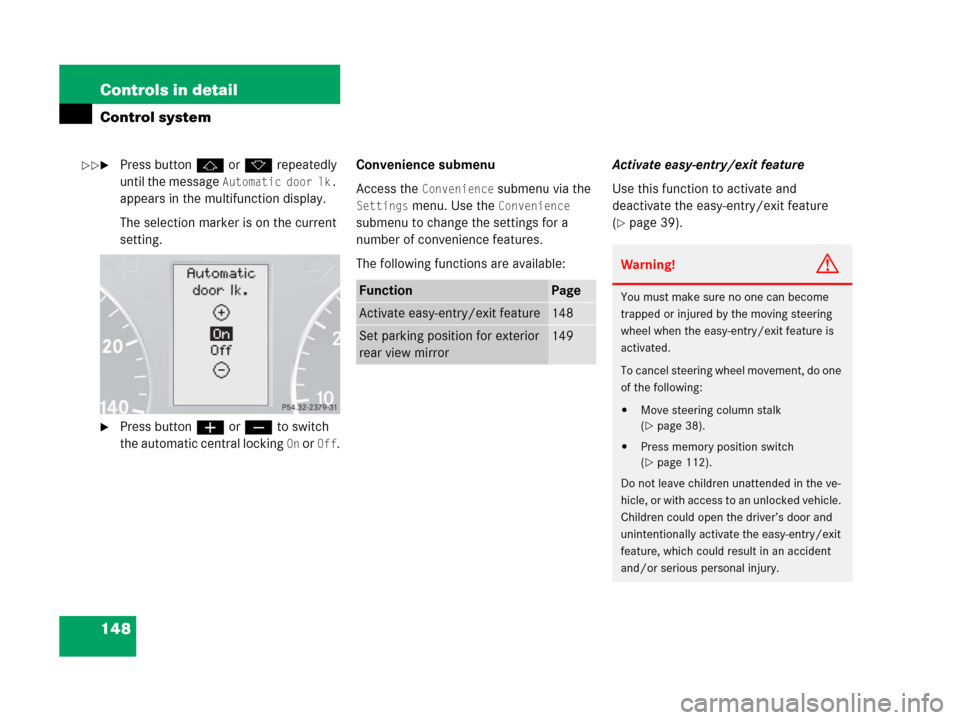
148 Controls in detail
Control system
�Press buttonj ork repeatedly
until the message
Automatic door lk.
appears in the multifunction display.
The selection marker is on the current
setting.
�Press buttonæ orç to switch
the automatic central locking
On or Off.Convenience submenu
Access the
Convenience submenu via the
Settings menu. Use the Convenience
submenu to change the settings for a
number of convenience features.
The following functions are available:Activate easy-entry/exit feature
Use this function to activate and
deactivate the easy-entry/exit feature
(
�page 39).
FunctionPage
Activate easy-entry/exit feature148
Set parking position for exterior
rear view mirror149
Warning!G
You must make sure no one can become
trapped or injured by the moving steering
wheel when the easy-entry/exit feature is
activated.
To cancel steering wheel movement, do one
of the following:
�Move steering column stalk
(
�page 38).
�Press memory position switch
(
�page 112).
Do not leave children unattended in the ve-
hicle, or with access to an unlocked vehicle.
Children could open the driver’s door and
unintentionally activate the easy-entry/exit
feature, which could result in an accident
and/or serious personal injury.
��